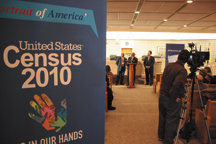The city of Bayonne saw a modest population increase for the second decade in row after more than seven decades of decline, according to figures released by the U.S. Census office.
The figures reflected the count done in 2010. Bayonne’s official population figure rose from 61,842 in Census 2000 to 63,024 in Census 2010.
“Bayonne’s population count from the 2010 Census is a sign of our community’s vitality,” said Mayor Mark Smith. “The number also reflects the hard work by the local census employees and strong support from the community.”
“Bayonne’s population count from the 2010 Census is a sign of our community’s vitality.” –Mayor Mark Smith
________
For residents here, an accurate count makes the difference between whether or not the county gets its fair share of the $400 billion distributed in federal aid each year. Bayonne would lose more than $2 million if the population was to dip below 50,000, city officials said.
Federal funds for local street-paving, senior nutrition programs, park repairs, and other municipal priorities come from the federal Community Development Block Grant, and depend directly on Bayonne’s population figures.
During the next decade, private businesses and all levels of government will use this information to help make a variety of policy and investment decisions about the community.
The census, which has been done every 10 years since 1790, determines political districts for the 435 seats in the U.S. House of Representatives among the 50 states, as well as determines the boundaries of state legislative districts.Bayonne was once known as a city of growth when its census count grew steadily from 3,828 in 1870 to 88,979 in 1930. The city began to see a gradual decline to 61,444 in 1990, and then an official increase of 398 in the 2000 census.
The city might have grown more during the 1990 to 2000 period had it not been for the closing of the Military Ocean Terminal, which employed nearly 2,000 military and civilian workers and had nearly 300 permanent residents. Not included in the 2000 census was the addition of new housing for airline personnel on Seventh Street, which was included in the current census.
Immigration was reason for increase in Bayonne
City officials said immigration was a major factor in Bayonne’s population increase. The Hispanic population rose from 11,015 in 2000 to 16,251 in 2010. The Asian population grew from 2,562 in 2000 to 4,861 in 2010. City officials are awaiting more details from the Census Bureau about the countries of origin represented by Hispanic and Asian populations. Hispanics can be of any race, and include several nationalities. The Asian category also includes people from many different nations.
People identifying themselves as white changed from 48,631 in 2000 to 43,618 in 2010. Residents listing themselves as black grew from 3,416 in 2000 to 5,584 in 2010. Those identifying as American Indians and Alaska natives increased from 106 in 2000 to 194 in 2010. The number of Native Hawaiians and other Pacific Islanders declined from 30 in 2000 to 16 in 2010. Similar trends emerged in the census at the state and national levels.
“The results of Census 2010 show that Bayonne’s population is growing in size and diversity,” Smith said. “Thanks to the official population increase, for the next decade, all of our residents will benefit from federal and state aid formulas that are based on population. We will study the census figures carefully to help us plan more progress for Bayonne in the years ahead.”
New housing was included
Public Information Director Joseph E. Ryan chaired the Bayonne Complete Count Committee for both Census 2000 and Census 2010. Ryan said that Bayonne’s preparations for Census 2010 began in 2006 and 2007. In those years, municipal officials and summer interns began updating the address list of Bayonne’s housing units from Census 2000. The address list process continued into early 2010, when the City of Bayonne asked the Census Bureau to include such new housing as the Alexan Cityview at the Peninsula at Bayonne Harbor.
“Getting the most updated address list to the Census Bureau was the most important part of our success, because the Census Bureau used the address list to mail out census forms in 2010,” Ryan said.
Other key factors in Census 2010, he said, included efforts by the Board of Education, houses of worship, and community groups to publicize the census.
The Board of Education got the word out with brochures, emails, and phone messages. He also cited the close cooperation between the City of Bayonne and the local census office.
Ryan stayed in touch with that office throughout the census house-to-house enumeration in spring and early summer of 2010.
During that time, he said, the municipality passed on information about housing units that might have been missed in the census mailing. Census employees needed to count the people who did not respond to the mailing.
Ryan thanked the census workers for coming to City Hall to look up addresses and other information on housing units.
“Those census workers went the extra mile to make sure that people were counted,” Ryan said. “The Tax Assessor’s Office was especially helpful in those efforts to find addresses.”
Al Sullivan may be reached at asullivan@hudsonreporter.com.
